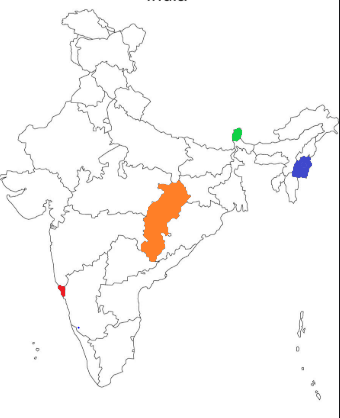Exercises Page No. 27
1. Locate the following States on a blank outline political map of India: Manipur, Sikkim, Chhattisgarh and Goa.
Answer.

| Green – SikkimBlue – ManipurOrange – ChattisgarhRed – Goa |
2. Identify and shade three federal countries (other than India) on a blank outline political map of the world.
Answer.
3. Point out one feature in the practice of federalism in India that is similar to and one feature that is different from that of Belgium.
Answer.
Feature in the practice of federalism in India that is similar to that of Belgium – There is power-sharing between the union government and state government.
Feature in the practice of federalism in India that is different from that of Belgium – India has no community government in practice, while Belgium has one.
4. What is the main difference between a federal form of government and a unitary one? Explain with an example.
Answer.
| Federal Form | Unitary Form |
| There is a sharing of power between union and state government. | The power is centralised with the union government, and there is no role of state governments. |
| Example – India (India is a federal country with union government at the centre and state governments at the state level and Panchayati Raj at the local level.) | Example – Sri Lanka (The national government has all the powers.) |
5. State any two differences between the local government before and after the Constitutional amendment in 1992.
Answer.
| Local Government Pre-1992 | Local Government Post Constitutional Amendment 1992 |
| Elections to these local governments were not held regularly | Now, it is constitutionally mandated to hold regular elections to local government bodies |
| Local governments did not have any powers or resources of their own. | The State governments are required to share some powers and revenue with local government bodies. The nature of sharing varies from State to State. |
6. Fill in the blanks:
Since the United States is a ___________________ type of federation, all the constituent States have equal powers and States are ______________vis-à-vis the federal government. But India is a _____________________ type of federation and some States have more power than others. In India, the ____________ government has more powers.
Answer.
Since the United States is a coming together type of the federation, all the constituent States have equal powers and States are strong vis-à-vis the federal government. But India is a holding together type of federation and some States have more power than others. In India, the central government has more powers.
7. Here are three reactions to the language policy followed in India. Give an argument and an example to support any of these positions.
Sangeeta: The policy of accommodation has strengthened national unity.
Arman: the Language-based States have divided us by making everyone conscious of their language.
Harish: This policy has only helped to consolidate the dominance of English over all other languages.
Answer.
The policy of accommodation mentioned by Sangeeta is a correct reaction to the language policy followed in India. Due to this policy, India stands in unity with states having different languages. Had India not followed the policy of accommodation, several states could have proposed separation from the country.
8. The distinguishing feature of a federal government is:
Answer.
d. Governmental power is divided between different levels of government
9. A few subjects in various Lists of the Indian Constitution are given here. Group them under the Union, State and Concurrent Lists as provided in the table below.
| Union List | |||
| State List | |||
| Concurrent List |
Answer.
| Union List | Defence | Communications | Banking |
| State List | Police | Agriculture | Trade |
| Concurrent List | Education | Forests | Marriages |
10. Examine the following pairs that give the level of government in India and the powers of the government at that level to make laws on the subjects mentioned against each. Which of the following pairs is not correctly matched?
| State government | State List |
| Central government | Union List |
| Central and State governments | Concurrent List |
| Local governments | Residuary powers |
Answer.
| Local governments | Residuary powers |
11.Match List-I with List-II and select the correct answer using the codes given below the lists:
| List-I | List-II |
| Union of India | Prime Minister |
| State | Sarpanch |
| Municipal Corporation | Governor |
| Gram Panchayat | Mayor |
Answer.
| List-I | List-II |
| Union of India | Prime Minister |
| State | Governor |
| Municipal Corporation | Mayor |
| Gram Panchayat | Sarpanch |
12. Consider the following two statements.
Which of the statements given above are correct?
Answer.
(c) A and B only
Chapter 2 of NCERT Social Science Civics textbook – Democratic Politics-II will introduce students to federalism, which is a power-sharing system between two or more levels of the government. In India, federalism exists. The power is divided amongst three levels – union government, state government and local government. Students will learn the basics of federalism in India with special mention to decentralisation. The local government called the ‘Panchayati Raj’ will be discussed.
The students will also get to know about the following topics:
a. Language policy
b. Centre-State relation
4. Decentralisation in India
Hemchandracharya North Gujarat University (HNGU) has announced the results for various UG and PG courses,…
Are you interested in learning about the Indian Army Ordnance Corps (AOC) Salary, Allowances, and…
RMLAU Result 2024 Declared: Check UG and PG Odd Semester Results at rmlau.ac.in The Dr.…
Rupal Rana's achievement of securing All India Rank 26 in the UPSC exams is not…
UPSC Calendar 2025 Released at upsc.gov.in: Check CSE, NDA, CDS, and Other Exam Notification, Application,…
JSSC Teacher Admit Card 2024 Released at jssc.nic.in: Download JPSTAACCE Call Letter Here The Jharkhand…
View Comments